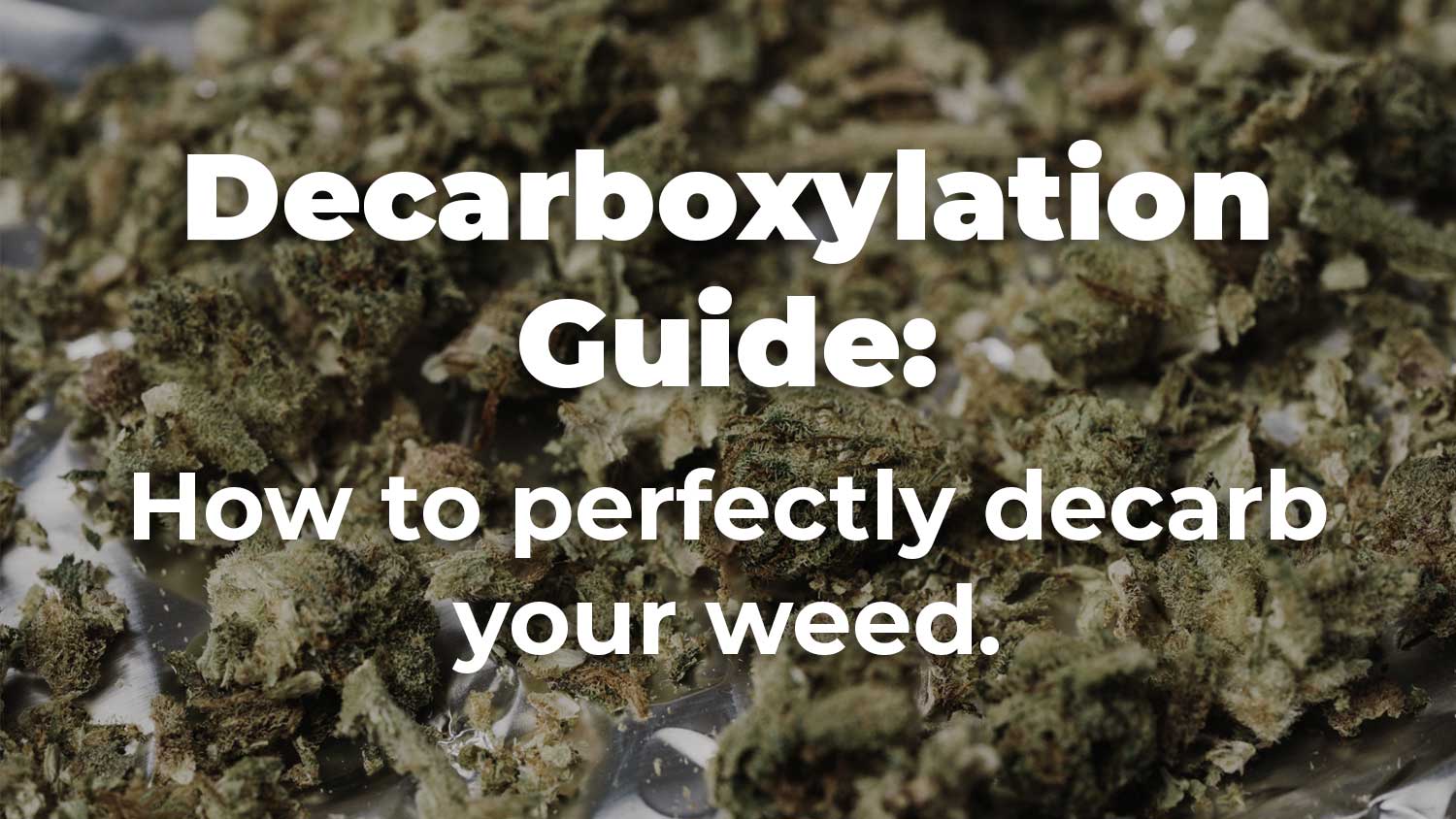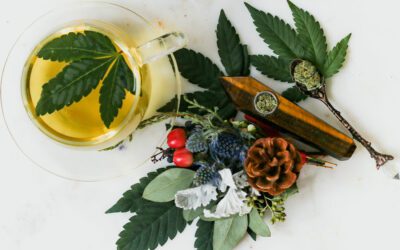If you’ve come in search of this article, you’ve already heard that your cannabis must first be put through a process called decarboxylation before being consumed in edible form.
Your first time decarbing can be an intimidating experience. After all, even the word itself is difficult to say. Wasted weed is wasted money, so mistakes can be costly, but fear not.
This step-by-step guide will break down the do’s and don’ts of decarboxylation and have you perfectly decarbing your cannabis every time, no experience necessary.
What is Decarboxylation and How Does it Work?
Decarboxylation is the process of activating the compounds in your cannabis (known as cannabinoids) so your body can absorb them and feel their psychoactive and medicinal effects.
These cannabinoids are found within various parts of the cannabis plant, including its flower, trim, leaves, stems, kief, and shake. All of these cannabis components can be decarbed and used to make infused edibles.
To explain a bit further, the THCa and CBDa molecules found in raw cannabis are known as cannabinoid acids or inactive cannabinoids. These molecules are primarily found within trichomes on the plant’s flowers but are also present in small quantities throughout the rest of the plant.
The THCa in your cannabis must go through a conversion process (decarboxylation) that changes its structure to interact with the endocannabinoid receptors in your body. This process is also responsible for converting CBDa into CBD, the major medicinal component found in cannabis.
When decarboxylation takes place within proper temperature ranges, most of these inactive cannabinoids are efficiently converted into activated THC and CBD, leaving only trace amounts of the cannabinoid acids behind. The activated cannabinoids in your cannabis can then be absorbed within your body once they’re consumed.
The Endocannabinoid System, or ECS, is a network of receptors found throughout your body and within your nervous system. ECS receptors play a role in major body functions such as appetite, pain, inflammation, sleep, mood, and more, and consuming decarbed cannabis can positively impact all of these systems.
The Importance of Preserving your Terpenes
Terpenes are the compounds that are primarily responsible for the smell of most plants and are found in very high concentrations in cannabis. Since many terpenes are bioactive (meaning they can interact with the human body), they possess the ability to amplify the medicinal and psychoactive effects of your high by acting within the endocannabinoid system in a similar way to cannabinoids. This phenomenon is known as the entourage effect.
Terpenes are very sensitive to elements like light, heat, oxygen, and humidity. Every time your cannabis is put through any physical or chemical process, some of these valuable compounds are lost. Proper storage and decarbing your cannabis correctly can help prevent some of this natural terpene loss. For these reasons, it is important to use the lowest temps possible during decarboxylation to maximize terpene preservation.
Overheating/burning your cannabis can result in major terpene loss and bitter flavor in your edibles, so ensuring the temperature accuracy of the appliance you choose to decarb with is very important.
Why is Decarboxylation Necessary?
When you smoke or vaporize your flower, the high temperatures from combustion and vaporization instantly convert your inactive cannabinoid acids into THC and CBD, allowing them to enter your endocannabinoid receptors, getting you high immediately. To get psychoactive and medicinal effects from cannabis in edible form, decarboxylation must first take place since no heat is added during their consumption. This process then allows you to turn your activated cannabis into salves, oils, tinctures, edibles, and infused beverages to use recreationally and medicinally.
Temperature Settings and Cook Times for the Perfect Decarb
Decarboxylation must take place under specific conditions with two variables in mind: heat and time. Studies have concluded that cannabis can be properly decarbed within a temperature range of 220-250 degrees, but the decarboxylation temperature for each cannabinoid and terpene varies. For example, THCa requires a temperature of 220 – 240 degrees Fahrenheit for 30 – 45 minutes to complete this process. CBDa requires a slightly longer cook time, with recommendations of 220 – 240 degrees Fahrenheit for up to 90 minutes. Full decarb time can vary depending on the type of plant material and how much is used. No matter how much cannabis you start with, low and slow is key for maximum terpene and cannabinoid preservation. Lower temperatures and longer cook times will aid in preserving these wonderful compounds and their many incredible potential health benefits. There are numerous methods available for decarbing your weed, and below we will explore a variety of options with optimum temperature ranges and cook times for various parts of your cannabis plant.
Should I Grind My Cannabis Before Decarbing?
Some how-tos suggest grinding cannabis before decarbing, but this process causes you to lose valuable terpenes in the trichomes that are caught within the bottom kief collection chamber, and we are all about preserving plant matter. To preserve as many of these precious compounds as possible, we recommend breaking your cannabis up to a medium-fine consistency with your fingers, so no grinding is necessary!
We will be using our Sour Giesel flower for this guide. You can use any plant material that you have available.
How to Decarboxylate Your Cannabis at Home
Please note that many of the decarbing techniques below will make your home smell very strongly of weed during and after the process. If you’re looking for maximum discretion, purchasing a home decarbing oven such as this will help to conceal the potent cannabis smell.
A multitude of devices made specifically for decarbing cannabis are available online, but these devices can be very costly. Since this professional equipment is not readily available for most of us, we will be exploring the simplest methods with common household appliances you probably already have.
Decarbing Cannabis in a Conventional or Toaster Oven
Tools and Ingredients needed:
- A conventional oven or toaster oven
- A baking sheet
- Parchment paper or foil (two sheets the size of your baking tray)
- Cannabis plant material of your choice (flower, shake, kief, stems, or trim)
Step 1: Preheat your oven to 240 degrees Fahrenheit.
Pro Tip: Newer ovens and appliances tend to be relatively accurate, but older gas ovens can be off by 20 or more degrees Fahrenheit, so we highly recommend purchasing an oven thermometer like this one that you can hang or set within your appliance to gauge its accuracy. Remember, weed is money, so being cautious is key.
Step 2: Use your fingers to break up your cannabis to a medium-small consistency.
Step 3: Cut a sheet of foil or parchment paper the size of your baking tray. Before laying it on the tray, crumple the sheet into a ball, unfolding it enough to spread out across your baking tray without smoothing it flat. This uneven surface will help guard against overheating your cannabis by minimizing direct contact from the hot surface of the baking tray.
Step 4: Spread your broken-up cannabis across the foil or parchment in a thin, even layer. Now lay your second sheet over the layer of cannabis, this time leaving the sheet flat.
Step 5: Place your cannabis in the oven, ensuring it remains as close to the center of the oven as possible. This is where your heat setting is most accurate, and heat rises, so it is important to be sure to keep your tray away from the top of the oven where temps can easily rise above your intended setting. Bake at 240 degrees Fahrenheit for 40-50 minutes, or until your cannabis is a slightly golden brown.
Pro Tip: If you’re looking for a higher CBD to THC ratio in your decarbed cannabis, allow your product to cook for 80 minutes at 240 degrees. A longer cook time activates more CBD and less THC!
Step 6: Carefully remove your cannabis from the oven and allow it to cool at room temperature for roughly 30 minutes. When your weed is cool to the touch, your decarboxylation process is complete!
Decarbing Cannabis in an Air Fryer
If you think decarbing in your oven is already simple, you will be happy to discover that decarbing in your air fryer is even easier. This is our favorite way to decarb weed!
Tools and Ingredients needed:
- An air fryer
- Aluminum foil
- Cannabis plant material of your choice (flower, shake, kief, stems, or trim)
- An oven-safe baking dish that will fit inside the basket of your air fryer
- Cheesecloth or mesh filter
Step 1: Preheat your air fryer to 250 degrees Fahrenheit and set a cook time of 60 minutes.
Step 2: Use your fingers to break up the plant material of your choice to a medium-small consistency. Spread your cannabis in a thin layer in the baking dish.
Step 3: Cover the baking dish with foil, poking tiny holes throughout the foil to release air during the decarb process. Place the entire dish inside your air fryer basket.
Step 4: Cook for a total of 60 minutes, stopping halfway at 30 minutes to give the baking dish a few small shakes to mix your cannabis around and keep it cooking as evenly as possible.
Step 5: Once your cannabis has reached a toasty golden brown, carefully remove it from the air fryer and allow it to cool at room temperature for roughly thirty minutes. When your weed is cool to the touch, your decarboxylation process is complete!
Decarbing Cannabis in a Slow Cooker
This method takes longer than the first two, but decarbing in a slow cooker is a very convenient, set-and-forget method that will allow you to decarb with minimal effort. This is also the most effective method on this list for concealing the cannabis smell without professional equipment.
Tools and Ingredients needed:
- A slow cooker
- A mason jar that will fit inside your slow cooker
- Cannabis plant material of your choice (flower, shake, kief, stems, or trim)
- Water
Step 1: Use your fingers to break up the plant material of your choice to a medium-small consistency. Place it into the mason jar, ensuring that your cannabis only takes up 1/4 – 1/2 of the jar.
Step 2: Set your slow cooker to high (around 210 degrees Fahrenheit in standard slow cookers).
Step 3: Fill the slow cooker halfway to the top with water. Place the lid tightly on your jar of cannabis and gently place it into the water, topping up if needed to keep the jar towards the top of the cooker.
Step 4: Set a timer and allow to simmer in the slow cooker for 4 hours, checking roughly every 90 minutes to ensure your water stays at the level you began with, topping off throughout this process as needed.
Step 5: Carefully remove the mason jar from the slow cooker and let it sit at room temperature until the jar is completely cool to the touch. Do NOT remove the lid from the mason jar until it has fully finished cooling. When your weed has reached room temperature, your decarboxylation process is complete!
Storing Decarboxylated Cannabis
Now that you’ve made it through the steps above, let’s talk about how to properly store decarbed cannabis to best preserve it.
It’s important to keep cannabis products (raw and decarbed flower, edibles, kief, infused butter, oils, etc.) in a cool, dry, dark place with little to no light. Airtight glass containers such as mason jars will provide the best preservation of cannabinoids and terpenes within your cannabis product.
Congratulations, you have successfully decarbed and stored your cannabis! With the activated THC and CBD within your weed, you can now make infused edibles, tinctures, salves, teas, butter, oils, and more.



![How To Roll A Blunt [EASY GUIDE]](https://redbudroots.com/wp-content/uploads/2020/12/how-to-roll-a-blunt-guide-400x250.jpeg)